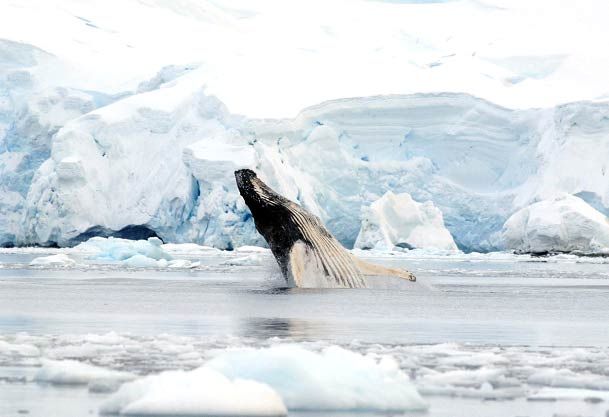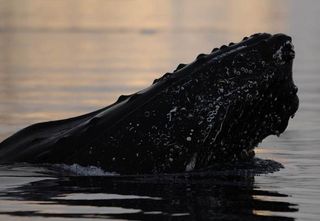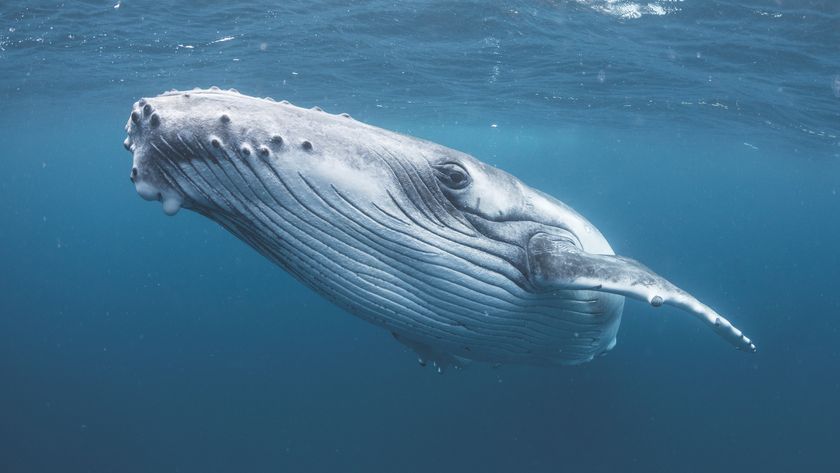
Whale of a Record: 306 Humpbacks Spotted Near Antarctica

A record-breaking crowd of humpback whales has been seen in chilly waters near Antarctica, giving researchers a unique opportunity to study the colossal creatures — not to mention a few thrills.
However, scientists warn the unprecedented whale numbers, drawn to the region for all-night feasting on their favored prey, may portend hard times ahead for the region's other residents in an ominous sign of climate change.
A research team saw the humpbacks, 306 all together, in tiny Wilhelmina Bay, a slice of water along the western side of the Antarctic Peninsula, a long finger of land that juts out from the continent and points toward South America. [In Photos: Tracking Humpback Whales.]
The research team counted five whales per square kilometer. Picture New York's Central Park, and that translates to 15 whales, each about 45 feet (13 meters) long, hanging around the premises. The previous observation record was about one whale per square kilometer.
"In the published literature this is the highest density estimate for humpback whales, period," said Ari Friedlaender, a research scientist at Duke University in North Carolina and co-author of a paper published today (April 27) in the online science journal PLoS ONE.
Researchers studied the bay during two six-week trips in May 2009 and 2010, a time of year when summer is waning and the colder weather of austral autumn is setting in. It was 2009 that saw record-breaking whale crowds, but similarly impressive numbers were around in 2010 as well.
Whale buffet
Sign up for the Live Science daily newsletter now
Get the world’s most fascinating discoveries delivered straight to your inbox.
Friedlaender said discovering they were floating amid a crowd of hundreds of whales, each longer than a school bus, was quite an experience.
"It was completely new and kind of shocking to be honest," Friedlaender told OurAmazingPlanet. "We're used to working in areas where you might run across five, 10, 15 whales in a day. We were not prepared for this in any way."
From their research vessel, the team witnessed whale gluttony that might make the Romans blush. The bay was teeming with tiny marine creatures called krill — humpback whales' favorite food — roughly 2 million tons worth, data indicate. Instruments aboard the ship showed the ghostly pink, shrimplike crustaceans were swarming the bay from the surface waters to as far as 985 feet (300 meters) down.
The whales would feed continuously for 12 or 14 hours, "gorging until 9 or 10 the next morning, when they would kind of go into a food

coma, and just be asleep on the surface," Friedlander said. "So it made counting them very easy."
But the researchers weren't just there to count the whales — they also affixed tags to the humpbacks, which, for the 24 hours they stay attached to the massive beasts, capture data on everything from temperature to sound to position, allowing researchers to construct a 3-dimensional map of the whale's underwater activities, complete with a soundtrack.
The lethargic whales sometimes barely budged when researchers paddled up in a small boat and thwapped a tag onto their heads. "A couple times we put tags on whales that didn't wake up, which is kind of embarrassing for the whales," Friedlaender said.
However, all the whale feasting and easy access for researchers may come with a high price, Friedlaender said, because of the complex relationship between krill, predators and sea ice, which is disappearing from the region.
Sea ice-free
Climate change is keeping the region ice-free for far longer than in past years, said Ted Scambos, a lead scientist at the National Snow and Ice Data Center (NSIDC), part of the University of Colorado.
The history of Antarctica's sea ice is a complicated one. Records indicate there was a huge drop in sea ice around the frigid continent sometime in the '60s or early '70s to near-present day levels — and there has been a slight increase in sea ice since then.
However, Scambos said, there is one big exception: the Antarctic Peninsula, particularly the western side, "where everything is going gangbusters in the direction of warming."
Changes in wind patterns have brought warm weather to the region, and the area around the peninsula has warmed by 4 or 4.5 degrees Fahrenheit in the last 50 years, Scambos said.
"It's already made a major transition from a coastline that was bound by ice most of the time, to a coastline that is surrounded by open water most of the time," Scambos told OurAmazingPlanet.
Crucial krill
Sea ice is crucial for krill populations, acting as a sanctuary, a nursery and a rich pasture for the tiny crustaceans.
Under the cover of sea ice, the young krill are shielded from predators, and the older krill feed on the algae and phytoplankton that live beneath the floating ice fortresses.
No sea ice means the krill are laid bare as an all-you-can-eat buffet for whales.
"You've got the krill getting it on both ends," Friedlander said.
In addition, creatures that are land-bound, such as penguins and seals, have a hard time reaching krill without sea ice, which provides a natural raft to reach the abundant food source.
"In the short term, the whales are going to be the ones that gain, but in the long term, if we increase the predation rate and decrease the amount of recruitment in the population, there's going to be less krill for everybody," Friedlaender said, adding that it's important to be aware of the situation, and understand what the extent of the challenges are going to be, especially since few people have the opportunity to see the region for themselves.
"It's a difficult experience to describe, being in a bay in Antarctica with a lot of whales," Friedlaender said. Photographs don't quite do it justice, he said.
"Down there it's all around you. It's hard to look at a photograph and get the feeling of being very small and very cold," he added. "If you get used to this, you need to readjust what you think is special."
- Creatures of the Frozen Deep: Antarctica's Weird Sea Life
- Image Gallery: Amazing Creatures from the Census of Marine Life
- Extreme Living: Scientists at the End of the Earth
Andrea Mustain is a staff writer for OurAmazingPlanet, a sister site to LiveScience. Reach her at amustain@techmedianetwork.com. Follow her on Twitter @AndreaMustain.












